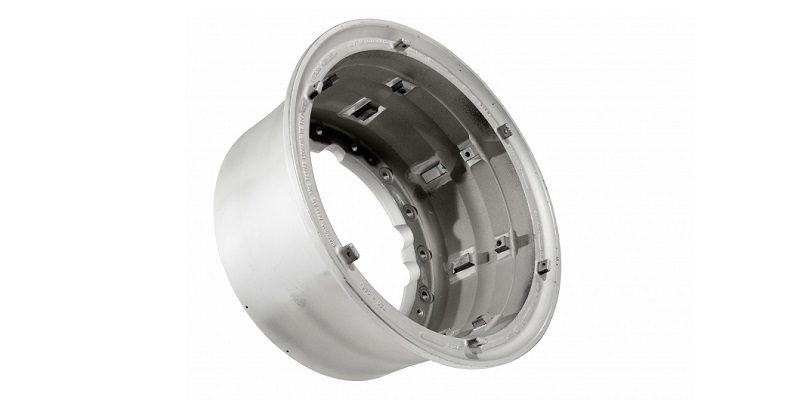
Wheel stripped of paint by wet blasting
Wet blasting is highly effective at stripping paint from all sorts of components like aircraft and car wheels and other metal and composite surfaces. We explain the benefits of using wet blasting to strip paint below, but before that, we cover some of the reasons why paint might need to be stripped off a component. Here are a few examples:
Repainting or refinishing: If you want to change the colour or appearance of a component, you will need to remove the existing paint before applying a new coat. This is often done for aesthetic reasons or to match a new design scheme.
Surface preparation: When painting or coating a component, it is important to have a clean, bare surface for optimal adhesion. Removing old paint ensures that the new coating will bond well to the component and provide better durability.
Inspection and assessment: Removing paint can allow for a thorough visual inspection of the component. It can help identify any underlying damage, cracks, corrosion, or defects that may be hidden beneath the paint layer. This is particularly important for critical components in industries such as aerospace or automotive.
Repair and maintenance: Paint removal might be necessary during the repair or maintenance of a component. It allows for easier access to the underlying structure, making it possible to address issues such as corrosion, cracks, or other forms of damage.
Surface treatment: Certain surface treatments, such as plating, require a bare metal surface. Removing paint is necessary to ensure proper adhesion and effectiveness of the treatment.

Aircraft wheels periodically require stripping for crack detection, a propeller blade about to be stripped of paint by wet blasting (see video below), a worker wearing protective clothing while dry blasting
The benefits of stripping paint by wet blasting - Wet blasting, also known as vapor blasting, is a method of paint stripping that involves blasting a slurry mix of water and a suitable abrasive at the component to remove the paint. 'A suitable abrasive' is usually a soft plastic media that doesn't affect the underlying surface. The hardness of the plastic can be increased to reflect the hardness of the paint that needs to be removed and it is even possible to remove just a top layer of paint leaving the primer layer in place. There are several benefits of stripping paint by wet blasting:
Gentle on surfaces: Wet blasting is a relatively gentle method compared to dry blasting techniques, such as dry blasting. The combination of water and abrasive creates a cushioning effect, reducing the likelihood of damage to delicate or sensitive surfaces. It is particularly useful for stripping paint from materials like aluminum and composites.
Dust-free operation: Wet blasting produces significantly less dust and airborne particles compared to dry blasting methods. The water acts as a suppressant, keeping the abrasive and paint particles contained. This makes it a preferred option in environments where dust control is essential, such as indoor settings or areas with sensitive equipment.
Improved operator safety: The use of water in wet blasting helps to minimise the generation of hazardous dust and fumes. This reduces the risk of inhalation of harmful particles, making it safer for operators and bystanders. It also eliminates the risk of explosion. Additionally, the water can help cool the surface being blasted, reducing the risk of heat-related damage.
Efficient paint removal: Wet blasting is effective in removing various coatings, including paint, rust, corrosion, and other contaminants in one operation. The combination of high-pressure water and abrasive materials can quickly and thoroughly strip paint from surfaces, even in hard-to-reach areas or complex shapes.
Environmentally friendly: Wet blasting is considered a more environmentally friendly option compared to some other paint stripping methods. The use of water reduces airborne pollutants and the need for harsh chemicals. Additionally, the abrasive media used in wet blasting is often recyclable, reducing waste generation.
Surface preparation: Wet blasting not only removes paint but also prepares the surface for subsequent treatments, such as coating or painting. It can create a clean, roughened surface to a specific Ra that improves adhesion for new coatings, ensuring a longer-lasting finish.
Watch the Vapormatt Puma wet blasting machine effortlessly strip paint from a propeller blade
Water Assisted Stripping Process (WASP)
Vapormatt’s Water Assisted Stripping Process (WASP) for paint removal by wet blasting has been developed specifically for aircraft wheel and brake shops involved with Maintenance, Repair, and Overhaul (MRO).
Using a specially configured wet blasting machine with plastic media, soaps, and high-powered nozzles, the WASP process is ideal for washing, degreasing, and paint removal of aircraft wheels and brake components.
With typically lower air pressures and a “scrubbing” media, WASP can remove paints, oils, and greases without damaging the substrate. This is a highly controllable process that can be adapted easily, making it ideal for unskilled manual operations.
Due to the abrasive nature of WASP, no solvents are required, this along with low pressure and a gentle wet blasting action helps ensure long machine life.